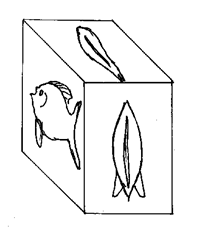Imaginary
Log This
trick enables the sculptor to visualise how the model looks actually inside a
log. The main blocking out cuts can then be planned on an actual log whilst referring
to the model inside its "log".
The model can be hard or soft so an original could be modelled in clay.
The principal is to re-create a hollow "log" in clear plastic sheet that
is to the same scale as the model. If
the sculptor is starting with the model, then the plastic sheet should be formed
into a regular tube around the model making sure that it is an easy fit. The overall
measurements of the tube correspond to the scaled up log that would be required
for that model. If
starting with the log, then the plastic sheet should be rolled into a cylinder
corresponding to the scaled down version of the logs measurements.The model should
then be made an easy fit inside the cylinder. Remember
not to include the bark in any measurement. | 


